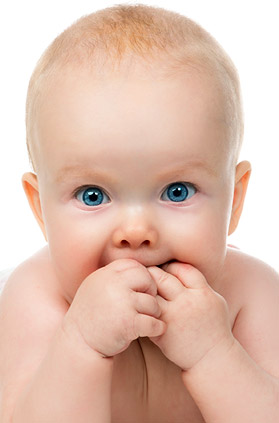What Baby is Trying to Tell You
Crying is just one way that your baby communicates. Every baby also gives his family physical cues that he is not comfortable. Those cues let us know how his central nervous system (CNS) is handling what is going on around him. If we learn to observe those cues and intervene for baby, we can avoid many meltdowns. Another benefit of this responsiveness is that it is a major part of the attachment process.
Cues that tell you baby needs a break from some stimulation around her. Your job is to identify the problem.
Top Five:
1. Rash Behavior
One of the first signs a baby will show is a spreading of extra color on the face. An example is that my grandson’s eyebrows turn red. Others will flush across the cheeks or ears or neck, or all three. If you think about it, this is exactly what adults do in response to stress too.
What to do? Turn down the sensory stimulation around him. Hold his hands to midline. Wait and watch his reaction. Talk reassuringly and calmly with him. Pick him up and hold him close to you while supporting his little feet for stabilizing his CNS. Put him in a smart swaddle and hold him if nothing else works.
Are the lights too bright or right over her head? Is she hearing loud voices, loud music or constant TV noise in the background? Has a cold wet one just been put on her bottom? BURRRR!
2. Open Mouth, Insert Hand
Some babies put their hands up to their mouth at the first sign of stress. Please allow baby to have this very important way to calm herself. Then look for sensory stimulation that may be too much for her at this time.
3. Environmental Disaster
If a baby temporarily loses her ability to suck on the breast, pacifier or finger, it may be because she is just too upset or stressed. Look around and see what is going on in her environment that you could calm down for her.
Baby really does still want and need her pacifier. She will be able to receive the comfort of sucking when she is not so cranky.
4. Look at it this way
Here is another one that is unsettling for parents. Baby cannot look at your face, so he turns away. Families can see this as rejection when the opposite is true. At some individual point, baby can’t tolerate anymore stimulation and needs a brief rest. Don’t worry, he will come right back to you when he is ready to engage!


5. Social Graces
Hiccups, sneezes, coughs and yawns are all signals that the central nervous system gives to “Re Boot” itself. That means baby may be cold (a stressor) when she sneezes, or she may be reacting to too many people in the room with her (another stressor). The movement and noises of too many people can be overwhelming.
The grocery store is another place that sets many infants off. Strange noises and people, and the way sound echoes in huge spaces may be the culprit. Include restaurants as offering the same kind of stressors that may require soothing from you.
Cues that say baby is ready to talk, hold, and/or play with you!
• Baby looks at your face or turns her head to you.
• Baby’s eyes become wide and bright.
• Baby’s face brightens.
• Baby makes feeding, cooing or babbling sounds.
• Baby reaches out to you with arms.
• Baby circles arms and legs with smooth movements.
© Copyright 2019 The Power of Nurturing Care. All Rights Reserved.
Website created by
iCatching Media
